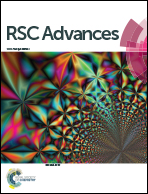Isolation of Bacillus amyloliquefaciens JK6 and identification of its lipopeptides surfactin for suppressing tomato bacterial wilt†
Abstract
A rhizobacteria strain, B. amyloliquefaciens JK6, isolated from the rhizosphere soil of healthy tomato plants, significantly inhibited Ralstonia solanacearum (RS). The biocontrol efficacies (BCEs) of JK6 suppressing tomato bacterial wilt caused by RS were up to 58.6% and 52.9% in two greenhouse experiments. To evaluate the mechanisms of the antagonist, we found that JK6 could produce siderophores, protease, biofilm, cellulose, indole acetic acid (IAA) and ammonium (NH3). In addition, PCR was used to identify antimicrobial genes in JK6. Amplification products of the expected sizes were identified as srfAB, involved in surfactin synthesis; ituA, ituB, ituC and ituD, involved in iturin synthesis; fenD, involved in fengycin synthesis; and yndJ, involved in the biosynthesis of the Yndj protein. The concentration of the lipopeptides surfactin isolated from JK6 culture was 64.24 mg L−1 identified by liquid chromatography coupled with mass spectroscopy. Furthermore, the srfAB, fenD and yndJ DNA content (copy number per 100 ng of total soil DNA) in the JK6-treated soil was significantly higher than that of the controls, as determined through real-time PCR analysis. In summary, we estimated that the production of lipopeptides surfactin as well as the higher srfAB, fenD and yndJ DNA copy numbers detected in the rhizosphere soil may play major roles in the biocontrol mechanisms with which JK6 protects plants from pathogen attacking.


 Please wait while we load your content...
Please wait while we load your content...